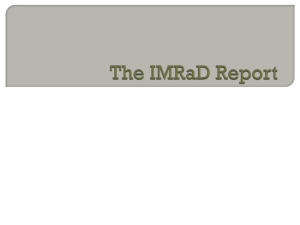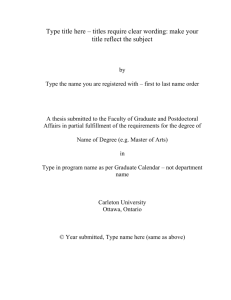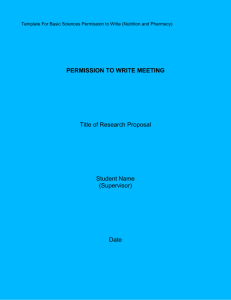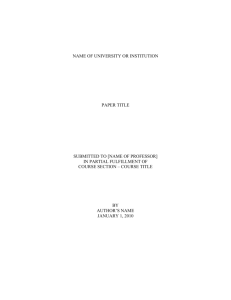Lab Report Template - College of Engineering & Science
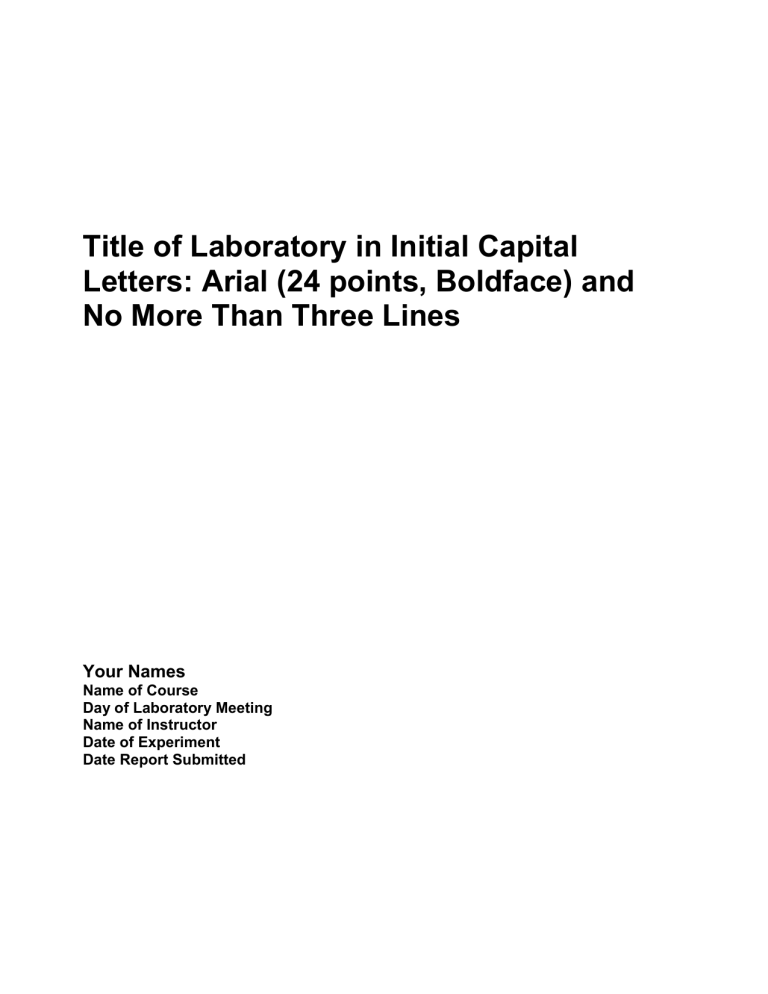
Title of Laboratory in Initial Capital
Letters: Arial (24 points, Boldface) and
No More Than Three Lines
Your Names
Name of Course
Day of Laboratory Meeting
Name of Instructor
Date of Experiment
Date Report Submitted
Abstract
The abstract is a statement of what you sought to learn or prove (the technical or scientific objectives), how you met those objectives, and what you found out. The abstract should be concise and to the point (one paragraph is typically adequate) and should be self-contained, that is, it should not refer to figures or sections of the main body of the report. Numerical results should be included if space permits, otherwise the nature of the results should be described in words. The quality and implications of the results should also be mentioned. The abstract should quickly summarize the content of the entire report. This part should be written as though it will be read by someone like a busy manager who does not have a lot of time and who may not be a technical expert.
Introduction
Headings are in 14 point font, flush left, and boldfaced. Use initial capitals. A good typeface for the heading is Arial, because it holds bold facing well. To preserve hierarchy, allot three line skips before the heading and two line skips after. The typeface given here for the text portion of this report is in 12 point Times New Roman (on a Macintosh, Times would a comparable choice). Book Antiqua would also be a professional choice. On a Macintosh, comparable typefaces to Book Antiqua are New Century Schoolbook and Palatino. In industry, the recommended spacing for a report is single spacing.
The “Introduction” of a laboratory report identifies the experiment to be undertaken, the objectives of the experiment, the importance of the experiment, and the overall background for understanding the experiment. The objectives of the experiment are important to state because these objectives are usually analyzed in the conclusion to determine whether the experiment succeeded.
The background often includes theoretical predictions for what the results should be. Overall, the
“Introduction” should orient the audience with sufficient background to understand what the problem is and why the problem was addressed.
In general, the organization of the report should be logical and each element of the report should build on the previous one and logically lead to the next. One of the keys to writing a logical report is to ensure that by the time any information, claim, or data is presented a framework has already been established for the reader to understand the presented information and its context. The presentation of information should guide the reader to the conclusion you wish to draw from your results. In addition, make sure that each section of the report transitions well to the following section; a good report will flow. Avoid simply answering the requested items in a linear fashion.
If equations are used, they must be numbered (as in “Eq. 1,” “Eq. 2,” etc.). Each should be referred to by number in the body text, and inserted at the point in the text near where they are first mentioned. When necessary, a citation for an equation’s source must also appear in the body text where the equation is first mentioned; for example:
...and this result was given by Eq. 1, a summation equation [Beckwith 2007, p. XXX], shown below. z = a + b + c + d + e + f (Eq. 1)
1
Brief, simple equations (e.g., “x = y + z”) can be inserted within the body text rather than on a separate double-spaced line.
Procedures
The “Procedures” section discusses how the experiment occurred. Documenting the procedures of your laboratory experiment is important not only so that others can repeat your results but also so that you can replicate the work later, if the need arises. Historically, laboratory procedures have been written as first-person narratives as opposed to second-person sets of instructions. Because your audience expects you to write the procedures as a narrative, you should do so.
Achieving a proper depth in laboratory procedures is challenging. In general, you should give the audience enough information that they could replicate your results. For that reason, you should include those details that affect the outcome. You do not put in trivial details such as the serial number of the equipment (though the model number should be included), nor the details of how the experiments are done. You can assume, for example, that a technical expert would know how to use standard pieces of equipment. Details about the equipment or data are needed only if a special feature or a special technique is required. However, items such as the dimensions of specimens (sometimes even a diagram) are often needed, as is information about displacement rates or gauge lengths in tensile tests or ambient temperature and pressure in fluids tests. These are not trivial details since, without them, someone couldn’t try to duplicate your experiments.
Do not make statements such as, “We followed the instructions given in the lab handout”
(or by the instructor). Your procedures must stand alone without reference to other sources unless the source is publicly available in a reliable document (see the section on references below).
Another formatting consideration concerns the incorporation of figures and tables. Shown in Figure 1 is a common format that serves reports well. Note that the word figure is not abbreviated. In a single column document, such an abbreviation makes no sense. A period is the powerful piece of punctuation—its primary use is to end sentences. Do not dilute its power by having it do menial tasks such as saving three letters from a word that is short to begin with.
Following standard convention, the formal introduction of Figure 1 occurred in the text before the figure appeared. In the introduction of an illustration, using pointers such as below or on the next page is undesired. Your technical reader knows where the illustration is supposed to be placed—after the paragraph that introduces it or on the next page if not enough space exists below the paragraph. Note that you should not break paragraphs in a document to insert an illustration. To distinguish the figure caption from the text, you should place the figure caption in a smaller typeface, as was done in Figure 1. Recommended line spacing of the caption is single spacing. For the caption, a nice touch is to place the name in the bold sans serif of the headings and have the caption’s text in the serif typeface of the chapter’s text. As is common in reports, the caption begins with a phrase and is followed by a sentence (or two) that explains unusual details.
2
Figure 1.
Title of figure in 11 point type beneath the illustration [Knost, 2004]. Feel free to add a sentence or two to point out important features.
Tables are presented in a different fashion. For instance, Table 1 presents an example. The heading for the table goes above and is in 11 point font. The heading is a single phrase. If there are unusual details, those are explained in footnotes beneath the table. Note that there is a line skip above and below that separates each illustration and its caption (or heading) from the text.
Table 1.
Heading for table in 11-point type [ CRC Handbook, 1969].
Planet
Mercury
Venus
Earth
Mars
Jupiter
Saturn
Diameter
(km)
5,100
12,600
12,800
6,900
143,600
120,600
Gravity
(earth ratio)
0.40
0.90
1.00
0.40
2.70
1.20
Year
(earth days)
88
225
365
687
4,333
10,759
Temperature
(K)
700
700
350
320
150
138
3
Uranus
Pluto*
53,400
12,700
1.00
???
30,686
90,885
90
80
*Corresponding data on Neptune not available.
Subheading
Subheadings should be in 12 point font and boldfaced. Insert two line skips before the subsubheading and one line skip after. Use initial capitals. Be conservative with subheadings in a report. A report is often an argument and, as such, requires a series of uninterrupted paragraphs to state assertions and present evidence for those assertions. At least one paragraph should follow a heading before a subheading exists.
Second Subheading
If you have one subheading, you must have a second. Otherwise, the first subheading has nothing to be parallel with. Do not allow a heading or subheading to stand as a widow line at the bottom of a page. If the situation occurs, force a line break before the heading or subheading.
Results and Discussion
The heart of a laboratory report is the presentation of the results and the discussion of those results. In some formats, “Results” and “Discussion” appear as separate sections. However,
[Medawar 1979] makes a strong case that the two should appear together, particularly when you have many results to present (otherwise, the audience is faced with a “dump” of information that is impossible to synthesize). Much here depends upon your experiment and the purpose of your laboratory report. Therefore, pay attention to what your laboratory instructor requests. Also, use your judgment. For instance, combine these sections when the discussion of your first result is needed to understand your second result, but separate these sections when it is useful to discuss the results as a whole after all results are reported.
In discussing the results, you should not only analyze the results, but also discuss the implications of those results. Moreover, pay attention to the errors that existed in the experiment, both where they originated and what their significance is for interpreting the reliability of conclusions. All results must be associated with experimental uncertainty, and quoted to an appropriate number of significant figures. All units within a report must be in a consistent system.
You must not mix units in a report (even if you took data in different units in the lab).
Details of the error calculations are not to be included in the report, nor should there be a laundry list of all possible errors. Rather, just the major source(s) of the uncertainty need to be stated. Showing the reader that you have thought about uncertainties to the extent that you can filter out the less important effects from the more important effects will have a major impact telling the reader that you know what you are doing. A laundry list along the lines of, “We considered the effects of
4
precision, accuracy, resolution and personal errors, and combined them using the root-sum-square equation,” just makes it look like the authors are trying to hide the fact that they really didn’t have a clue what they were doing.
As you can assume for experimental procedures, you can also assume that the reader is technically savvy enough to do the analysis. In your reports, however, you must give enough information to the reader so that he or she knows what you did and why you did it. Provide enough of a framework for the reader to be able to use his or her experience to fill in the gaps. Thus, you do not provide every step in an analysis, but you provide the results of enough intermediate steps in complicated analyses so that the reader can understand your thought process and can verify that all the steps are free of error.
One important way to present numerical results is to show them in graphs. Some helpful guidelines for presenting information graphically are given below:
Points and lines on graphs:
Do NOT connect data points if the phenomenon you’re graphing is not continuous.
Do NOT connect points with straight line segments unless there is significance to the straight lines.
If you’re going to draw a curve to fit the data, DO draw a smooth curve, unless you have a specific reason not to. Also identify the fitted curve on the graph.
DO remove extraneous data points that clearly come from noise.
Uncertainty and error bars:
DO always indicate a measure of uncertainty on your graphs (for example, error bars).
Error bars do NOT need to be equal sizes in all directions.
Do NOT show individual error bars for points on a graph when doing so would crowd the plot and obscure the data points (instead, use a few representative error bars or use labeled lines that show the range of uncertainty).
Axis labels, tick marks, and divisions:
Unless you have a particular reason not to, DO show the origin on graphs.
Do NOT use excessive significant figures for numerical labels.
Moreover, DO choose units for numerical axis labels that eliminate excessive, insignificant leading zeros or trailing zeros (for example, 1000000 Pa will be more easily understood as 1000 kPa or 1.0 MPa, depending on the number of significant digits required).
Do NOT use unconventional intervals for tick marks on axes (for example, if the major ticks are in increments of 2, don’t use 5 minor tick marks…).
DO use full words in axis labels (symbols or letters may be added in parentheses).
DO indicate units in labels (after a comma or in parentheses -- spell-out or use standard SI abbreviations)
DO use proper subscripts and symbols in labels if required.
Do NOT use programming symbols in labels; that is, don’t use *, ^, E, etc. (as in 10E6 or 1*10^6 to mean 10 6 ).
General design guidelines:
DO compose titles for figures and tables that are informative ( can be complete sentences, with more than one line of text when necessary).
5
Do NOT rely on different colors to distinguish between different plots (your report may be photocopied in black and white).
DO identify different curves with a legend or callouts.
Do NOT use a colored (or gray) background.
Do NOT use grid lines (unless you have a particular reason to do so).
Conclusions
In longer laboratory reports, a “Conclusion” section often appears. Whereas the “Results and Discussion” section has discussed the results individually, the “Conclusion” section discusses the results in the context of the entire experiment. Usually, the objectives mentioned in the
“Introduction” are examined to determine whether the experiment succeeded. If the objectives were not met, you should analyze why the results were not as predicted. Note that in shorter reports or in reports where “Discussion” is a separate section from “Results,” you often do not have a
“Conclusion” section.
The conclusion section should not be a mere summary of the experiment and its results.
References
For the purposes of this class, you can assume that any knowledge or concepts that you would be expected to know for the final exam of the pre- or co-requisite classes are common knowledge. You do not need to reference this material, but you do need to define any variables or parameters that appear as special symbols in your report. In addition, you must provide a reference for all information that is more advanced, and for material properties.
If you ever copy text from any source, you must provide a citation and put the copied text in quotation marks. If you copy a figure from any source, you must cite the source and make it clear that the figure is a photocopy. If you copy an equation from any source, you must cite the source. If you present an idea from any source in your own words, you must cite the source. Failure to provide correct citations (or/and quotation marks) at the point in your report where you have borrowed or copied an idea is considered to be plagiarism. Plagiarism is a serious violation of the
College policy, consult the Engineering and Science Student Handbook.
References must consist of trusted information that is available to the public. Despite recent technological advances, the shelves of libraries still contain many of the best references in the form of refereed journals, textbooks, and reference manuals. Reference to online materials should be avoided if at all possible.
Beckwith, T.G., Marangoni, R.D., and Leinhard, J.H., Mechanical Measurements (Pearson Prentice
Hall: New York, New York 2007).
Chyu, M. K., “Heat Transfer and Pressure Drop for Short Pin-Fin Arrays with Pin-Endwall Fillet,”
Journal of Turbomachinery , vol. 112 (1990), pp. 926-932.
6
Clements, Terry C., “Request for Testing of Centrifugal Fan with Adjustable Inlet Guide Vanes,” memo to Pat Hodges (Birmingham, AL: Sewel Manufacturing, 24 August 2005).
CRC Handbook of Chemistry and Physics, 75th ed. (New York: Chemical Rubber Publishing
Company, 1995), chap. 14, p. 3.
Han, J. C., and Y. M. Zhang, “High Performance Heat Transfer Ducts with Parallel Broken and V-
Shaped Broken Ribs,”
International Journal of Heat and Mass Transfer , vol. 35 no. 2 (1992), pp. 513-523.
Kays, W., and Crawford, M., Convective Heat and Mass Transfer (McGraw Hill: New York, New
York, 1993).
Knost, Daniel, “Experiment to Measure the Internal Pressure of a Soda Can,” photograph
(Blacksburg, VA: Virginia Tech, 9 April 2004).
7
Appendix A:
Title of Appendix A
In a laboratory report, appendices often are included. One type of appendix that appears in laboratory reports presents information that is too detailed to be placed into the report's text. For example, if you had a long table giving voltage-current measurements for an RLC circuit, you might place this tabular information in an appendix and include a graph of the data in the report's text. If you had a set of involved calculations, they might also be included in an appendix. Another type of appendix that often appears in laboratory reports presents tangential information that does not directly concern the experiment's objectives.
If the appendix is “formal,” it should contain a beginning, middle, and ending. For example, if the appendix contains tables of test data, the appendix should not only contain the tabular data, but also formally introduce those tables, discuss why they have been included, and explain the unusual aspects that might confuse the reader. Because of time constraints, your instructor might allow you to include “informal” appendices with calculations and supplemental information. For such “informal” situations, having a clear beginning, middle, and ending is not necessary.
However, you should still title the appendix, place a heading on each table, place a caption beneath each figure, and insert comments necessary for reader understanding. Illustrations in this appendix are labeled Figure A-1, Figure A-2, Table A-1, Table A-2, and so forth. Note that each appendix begins on a new page. Also note that each appendix should be introduced somewhere in the text portion of the report.
8
Appendix B:
Title of Appendix B
Illustrations in this appendix are labeled Figure B-1, Figure B-2, Table B-1, Table B-2, and so forth. Depending on the situation, you might have more or fewer appendices.
9
